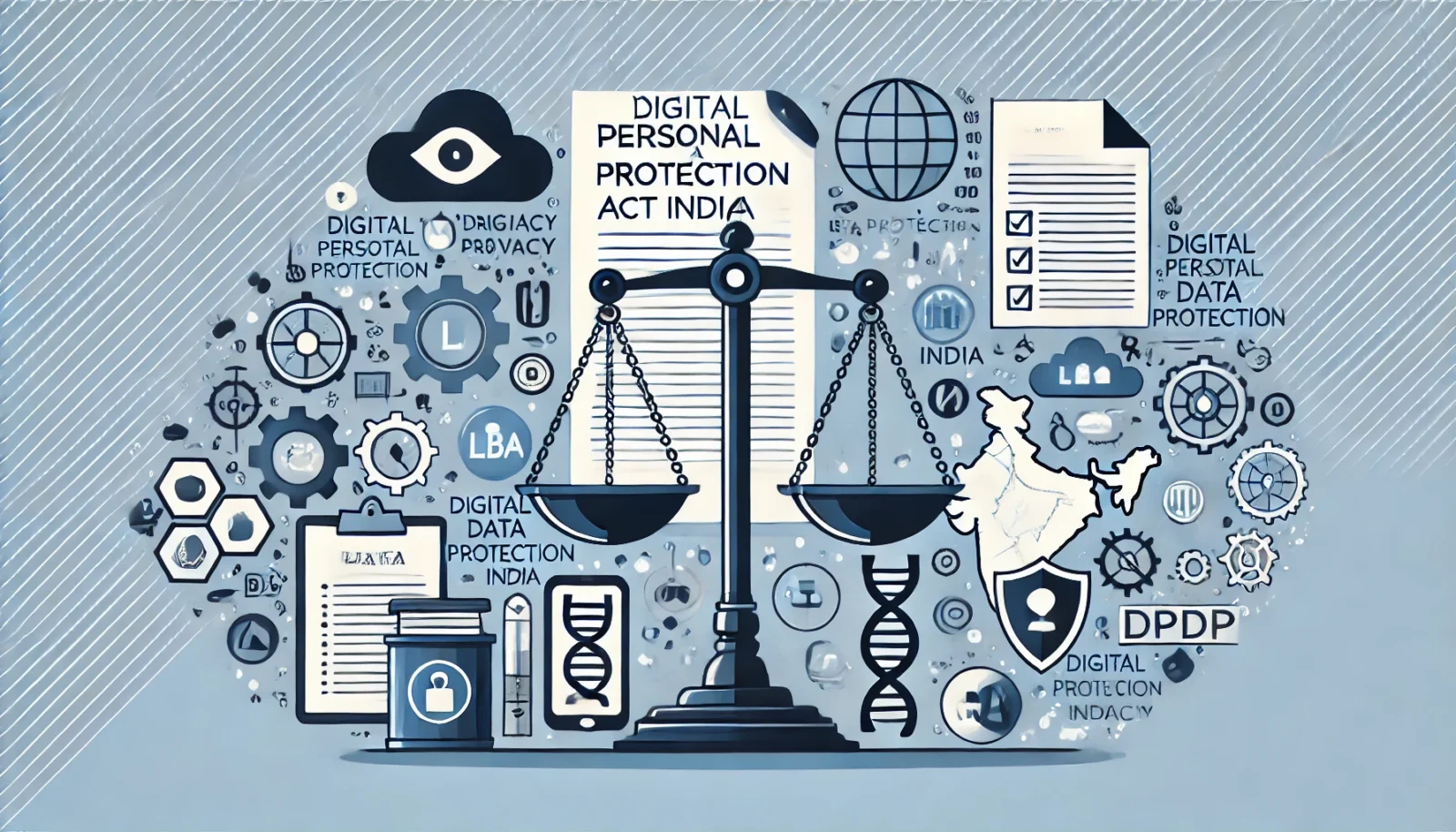In the digital age, where personal data drives innovation and commerce, protecting this sensitive information has become essential. The DPDP Digital Personal Data Protection Act is a transformative piece of legislation designed to safeguard individual privacy and strengthen trust in digital ecosystems.
Let’s understand the key aspects and importance of DPDP law, clarifying its objectives, scope, and implications.
Overview of DPDP Digital Personal Data Protection Act
Background and Purpose of the Act
The DPDP Act was created to address worries about how personal data is used and the potential for privacy violations. As countries try to find a balance between technological progress and protecting people’s rights, this Act plays an important role in making sure that personal information is handled in a responsible way. It sets clear rules for how data is collected, used, and kept secure, helping to protect individuals in our digital world.
Key Objectives of the Legislation
The main purposes of the DPDP Act are simple but important. It wants to give people more control over their personal information, make sure that companies are responsible for how they use that information, and set up rules that are similar to those used around the world. By achieving these goals, the Act aims to build trust in online transactions and make our data safer.
The Importance of Data Protection in the Digital Era
Why Personal Data Needs Protection
Personal Data—like your bank details and medical records can be misused if it gets into the wrong hands. Keeping this information safe helps people retain control over their lives and protects them from dangers like identity theft, money scams, and targeted online attacks.
Risks of Data Breaches and Misuse
Data breaches can put personal information at risk and lead to a loss of trust in organizations. Major incidents have shown just how serious the effects can be, including damage to reputations and large financial penalties. To tackle these threats, the DPDP Act sets up strict rules to better protect people’s data.
Defining Digital Personal Data
What Constitutes Personal Data
The DPDP Act defines personal data as any information that can help identify someone, either directly or indirectly. This means things like names, phone numbers, fingerprint data, and even how people behave online are all considered personal data.
Types of Data Covered Under the Act
The Act includes different types of information, such as sensitive personal details like health records and financial information, as well as data that has been made anonymous and information about children. By covering all these areas, it provides thorough protection for everyone’s information.
Scope of the DPDP Act
Who the Act Applies To
The DPDP Act is a law that applies to anyone involved in handling personal information, whether they are individuals or companies. This includes those who control the data, those who process it, and even outside companies that manage this information.
Industries and Sectors Impacted
The DPDP Act impacts a wide range of industries, including online shopping, healthcare, banking, and education. Essentially, any business that uses personal data must follow its rules to ensure they are handling that information responsibly and safely.
Core Principles of the DPDP Act
Transparency and Accountability
The Act highlights the need for clear and open communication about how organizations handle our data. Companies must inform us about how they collect, use, and keep our information safe. They also need to take responsibility for any mistakes they make in this process.need to take responsibility for any mistakes they make in this process.
Lawful Processing of Data
When handling data, it’s important to follow the law. This means you should only process information if you have permission, if it’s needed for a contract, or if you are required to do so by law. It’s essential to avoid any unauthorized or dishonest actions in this process.
User Rights and Consent
The DPDP Act gives people more control over their personal information. It allows them to see what data is held about them, correct any mistakes in that information, and withdraw their permission for its use whenever they choose.
Key Provisions of the DPDP Act
Rules for Data Collection
Organizations should carefully consider the types of information they collect, ensuring that they gather only what is necessary for clearly defined objectives. It is important for them to establish specific reasons for data collection to avoid unnecessary accumulation of personal or sensitive information. Furthermore, organizations must implement strict policies and practices to ensure that this data is used exclusively for the intended purposes, thereby safeguarding user privacy and maintaining trust. Regular audits and reviews should be conducted to confirm adherence to these principles, ensuring that data management practices align with ethical standards and legal regulations.
Data Storage and Retention Policies
According to legal regulations, it is essential to ensure that data is kept secure and retained only for the duration necessary to fulfill its intended purpose. Storing data beyond this required timeframe is deemed inappropriate and could lead to legal implications.
Cross-Border Data Transfers
When transferring data across international boundaries, robust safeguards must be established to protect the information being shared. These safeguards must ensure that the country receiving the data maintains protection standards that are comparable to those of the originating country. This involves implementing measures that safeguard personal privacy and data integrity, thereby minimizing the risk of unauthorized access or misuse. Such practices are important not only for compliance with legal and regulatory frameworks but also for fostering trust between organizations and individuals regarding data handling and security.
Consent Management Under the DPDP Act
Importance of Obtaining Clear Consent
Informed consent is fundamental to the DPDP Act. It is essential for users to have a clear understanding of what they are agreeing to when providing consent. Additionally, individuals should also have the ability to opt out of these agreements if they choose to do so.
Methods to Ensure Valid Consent
Organizations can enhance the process of obtaining consent by implementing transparent policies, providing clear and accessible terms of service, and designing user-friendly interfaces. These practices help ensure that users fully understand what they are consenting to, making their agreement truly informed and voluntary.
User Rights Protected by the DPDP Act
Right to Access Data
It is important for individuals to be aware of the information that companies collect about them, as well as the purposes for which this data is utilized. Understanding these practices can empower consumers to make informed decisions regarding their privacy and data security.
Right to Correct or Erase Data
Users have the ability to request corrections for any inaccurate data and can also ask for the deletion of information that is no longer deemed necessary.
Right to Data Portability
The Act facilitates the transfer of data between different service providers, empowering individuals and promoting competition in the market. This enhances user autonomy by allowing people greater control over their information.
Responsibilities of Data Controllers
Obligations Toward Data Security
Data controllers are required to implement comprehensive security measures to safeguard sensitive information and prevent potential breaches. This includes utilizing strong encryption techniques to protect data both in transit and at rest, ensuring that even if unauthorized access occurs, the information remains unreadable. Additionally, regular audits should be conducted to assess the effectiveness of these security protocols and identify any vulnerabilities. These audits should encompass thorough reviews of access controls, data handling practices, and incident response plans. By establishing a proactive security posture, data controllers can significantly reduce the likelihood of data breaches and enhance overall data integrity.
Responding to Data Subject Requests
Organizations must quickly respond to user requests for access to, correction of, or deletion of their data. This means they need to provide timely answers so individuals can easily find out about their data, correct any errors, or ask for their data to be removed. Fast and clear responses help support user rights and build trust.
Role of Data Protection Officers
Who Needs a Data Protection Officer
Any organization that manages a lot of personal or sensitive information needs to have a person in charge of protecting that data, known as a Data Protection Officer (DPO). This role is essential for ensuring that people’s information is kept safe and handled properly.
Responsibilities and Qualifications
DPOs are tasked with overseeing compliance, conducting impact assessments, and serving as the primary liaison with regulatory authorities.
Penalties for Non-Compliance
Fines and Legal Consequences
Failure to comply with the Digital Personal Data Protection (DPDP) Act can lead to significant penalties, including hefty fines that could have a substantial financial impact on an organization. In addition to financial repercussions, non-compliance can also damage a company’s reputation, eroding customer trust and confidence in its ability to handle personal data responsibly. Furthermore, organizations may face the risk of legal action, which could result in extended litigation costs and further impacts on their operational integrity. Ensuring adherence to the DPDP Act is therefore crucial for maintaining both regulatory compliance and a positive public image.
Case Studies of Potential Violations
Analyzing potential errors that organizations might encounter provides valuable insights into the consequences of not adhering to established regulations and guidelines. Understanding these risks is essential for promoting compliance and preventing negative outcomes.
Impact of the DPDP Act on Businesses
Challenges for Organizations
Adapting to the requirements set forth by the Digital Personal Data Protection (DPDP) Act can be a resource-intensive process for organizations. This adaptation often involves significant modifications to various aspects of their operations, including technological infrastructure, organizational policies, and everyday practices. For instance, businesses may need to invest in new data management systems or upgrade existing ones to ensure compliance with the stringent data handling and processing guidelines outlined in the Act. This also includes implementing robust security measures to protect personal data against unauthorized access or breaches.
Additionally, organizations may have to revise their internal policies to align with the principles of transparency, user consent, and data minimization emphasized by the DPDP Act. Training staff to understand and adopt these new policies is equally crucial, which can require considerable time and resources.
Overall, the shift toward full compliance with the DPDP Act entails a comprehensive evaluation and overhaul of data governance strategies, demanding both financial investment and strategic planning to effectively meet the regulatory expectations.
Opportunities for Better Data Management
Compliance provides organizations with an opportunity to enhance their data management practices, foster trust among stakeholders, and secure a competitive advantage in the marketplace.
Cross-Border Implications of the DPDP Act
Rules for International Data Transfers
The Act establishes stringent guidelines that govern cross-border data transfers, ensuring that such transfers take place only under carefully defined conditions. These conditions are designed to safeguard the security and privacy of data, thereby protecting individuals’ personal information from potential risks associated with international exchanges. The framework mandates that adequate measures must be in place to uphold data integrity, limit access to authorized personnel, and ensure compliance with privacy standards, ultimately fostering trust in the handling of sensitive information across borders.
Aligning with Global Data Protection Standards
By adhering to international norms, the DPDP Act facilitates global interoperability and trust in digital commerce.
How the DPDP Act Compares to Other Laws
Differences Between DPDP and GDPR
The Data Protection and Digital Privacy (DPDP) Act takes cues from the General Data Protection Regulation (GDPR) but introduces unique provisions tailored to fit the specific needs and circumstances of the country it serves. One of the key features of the DPDP Act is its mandate for localized data storage, which requires that certain types of data be stored within national borders. This provision is aimed at enhancing data sovereignty and ensuring that the information of citizens remains subject to national laws and regulations. Additionally, the act emphasizes the importance of protecting personal data in a manner that respects the cultural, legal, and economic context of the nation, making it a comprehensive framework for data privacy and protection.
Similarities with Other National Laws
The Act aligns with the objectives of legislation such as the California Consumer Privacy Act (CCPA), emphasizing the importance of user rights and data accountability.
Technology and the DPDP Act
Role of AI and Automation in Compliance
AI-driven tools can enhance compliance processes by automating tasks such as consent management, conducting data audits, and performing risk assessments. This automation not only increases efficiency but also helps organizations maintain regulatory standards more effectively.
Tools to Simplify Data Protection
Technology is crucial in ensuring compliance with the mandates of the DPDP Act, encompassing a range of tools such as encryption software and compliance platforms. These technologies facilitate adherence to regulatory requirements and enhance data protection measures.
Steps to Comply with the DPDP Act
Conducting a Data Audit
Conducting regular audits is essential for organizations as it allows them to systematically identify potential vulnerabilities within their operations. These audits provide a comprehensive review of processes and practices, enabling organizations to pinpoint areas where they may be at risk or falling short of compliance with relevant regulations and standards. By addressing these issues proactively, organizations can implement corrective measures to rectify non-compliant practices, enhance overall security, and ensure they are adhering to best practices in their industry. Ultimately, regular audits serve not only to safeguard against risks but also to promote a culture of accountability and continuous improvement within the organization.
Implementing Data Protection Policies
Comprehensive policies establish clear and detailed protocols for the handling of data, which serve to ensure both consistency and compliance across all levels of the organization. These policies specify procedures for data collection, storage, processing, and sharing, addressing potential risks and outlining best practices that employees must follow. By implementing these structured guidelines, the organization aims to safeguard sensitive information, promote transparency in data management, and adhere to relevant legal and regulatory requirements, ultimately fostering a culture of accountability and trust.
Employee Training and Awareness
Providing employees with information about the Act helps to cultivate a culture of accountability within the organization. This proactive approach can significantly minimize the risk of unintentional violations.
Common Misconceptions About the DPDP Act
Myths vs Facts
Debunking common myths helps organizations anDispelling common myths is really important for both organizations and individuals. It helps everyone get a better grasp of what the Act truly means for them. When we can clear up these misunderstandings, it makes it easier to see the real goals and effects of the legislation. This understanding can lead to smarter choices and better ways to follow the rules. Plus, it opens up a friendly conversation about the Act and how it impacts our lives and work!d individuals understand the Act’s true implications.
Addressing Concerns of Small Businesses
Providing support that is specifically designed for smaller businesses ensures that they can meet necessary regulations and requirements without facing excessive stress or difficulty. This tailored guidance helps these enterprises navigate complex rules, making the process easier and more manageable for them.
The Future of Digital Personal Data Protection
Emerging Trends in Data Security
Recent advancements in technology, including blockchain and decentralized storage, are significantly transforming the landscape of data protection. These innovations offer enhanced security and privacy solutions, providing new ways to safeguard sensitive information.
Expected Amendments to the Act
As technology advances at a rapid pace, it is expected that the DPDP Act will undergo significant revisions to effectively tackle the emerging challenges and seize new opportunities presented by these developments. These updates will aim to ensure that the legislation remains relevant and protective in an ever-changing digital landscape. and opportunities that arise.
Summary of Key Takeaways
The DPDP Act represents a significant advancement in data protection legislation. It provides comprehensive safeguards for individuals’ data while also empowering users with greater control over their personal information.
Encouraging Awareness and Compliance
By actively embracing the provisions of the Act, both organizations and individuals have the opportunity to play a significant role in fostering a safer and more trustworthy digital environment. This commitment not only enhances security measures but also encourages transparency and accountability in online interactions. Through collective efforts, stakeholders can build a digital landscape that prioritizes the protection of user data, promotes ethical practices, and mitigates risks associated with cyber threats. Ultimately, this collaborative approach can lead to a more reliable and secure online experience for everyone involved.
Download copy of Digital Personal Data Protection (DPDP) Act 2023













Leave a comment